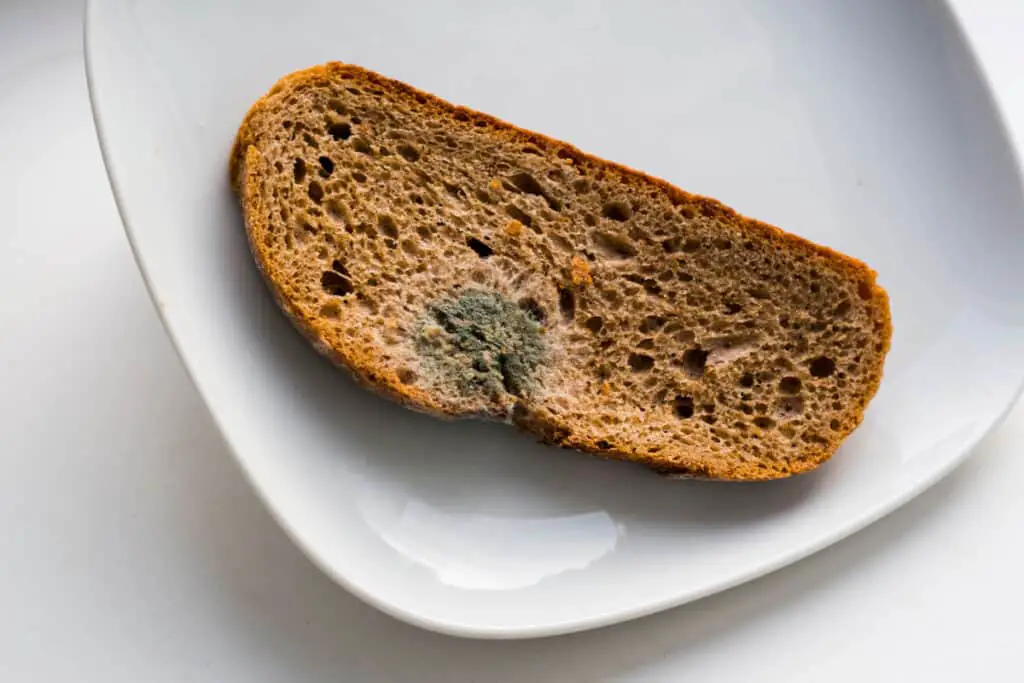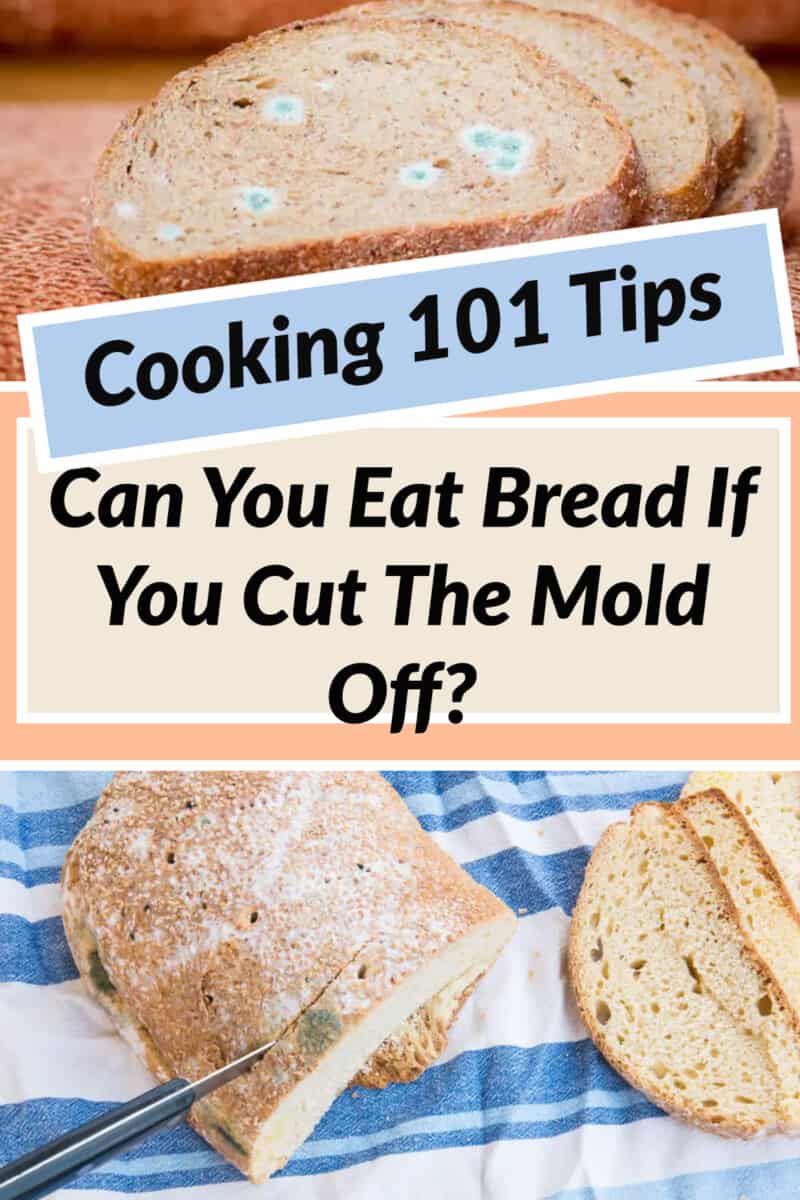This post contains affiliate links.
Bread is a staple of food assortments that we should be storing and eating. However, like all good food, they tend to go bad and there is a common misconception of food products and especially bread that if it begins to mold, you can simply remove the molded spots and proceed to eat the rest of the bread with no worries. There is much more to learn about this that most people do not know or have not yet grasped.
Bread that is moldy in any way should not be eaten. Even small mold spots turn the bread into a nonedible product. Just a little mold has already spread throughout the bread in one way or another. The bread is already done once mold has been in place, which wastes away the bread.
You may have been doing this for a while now but don’t worry, it is not the end of the world for you. We are here to provide and make you aware of these kinds of situations. All information here should help you know the cons and why you should never eat a moldy bread of any degree and hopefully help you find alternative methods to extend your bread’s life for future use.
What Is This mold?
Looking at the mold itself on a piece of bread, you may notice some of its distinguishing and disgusting attributes such as the discolored blue, yellow, or green tint, and the soft hairs that surround each mold spot. Without a doubt, this is mold at its finest and it wreaks havoc within the product it is inhabiting. For the bread’s case, the most common type of mold is called Rhizopus Stolonifer.
This is a fungus which means it is a spore that feeds on other organisms such as fruits and vegetables, being the most common for this fungus. But as we are concerned, it indeed affects other types of food products such as bread. And with these spores comes the concept of sporangium which is defined as spores reproducing and therefore spreading throughout the area of inhabitance.
So, once a little mold has been found in any of the bread products, the likely chances that the spores within this fungus have spread are very high. Every crevice of the bread is subject to be filled with spores that will no doubt grow and repeat this entire process of multiplying and replenishing. We also have to briefly understand the conditions in which mold is to be produced. Factors that include, temperature, moisture, light, and much more all contribute to whether or not mold begins to grow sooner or later, and if it is fast- or slow-growing.
What if We Consume the Mold?
Briefly identifying and understanding the basic concept of the fungus, what effects can it have on our body if we end up consuming bread with such molds on it? In most cases, those who are usually healthy will have no worries about fatal outcomes. Eating some mold accidentally here and there will not be a significant detriment to the human body.

The only effects that will be apparent are ones that briefly upset the stomach and other potential digestive problems. Never, is there a time when eating a little is severe to our mortality. If we end up eating a significant amount of mold in our bodies, however, it may have a greater impact on our overall health that could result in severe, but not fatal, discomfort and professional medical assistance may be in order.
Rare instances of issues that are deadly are increased risk of cancer of some kind if exposed to any degree of mold for long periods. Any issues with mold consumption will be fixed with proper help and procedures. Overall, it is best to avoid consuming altogether, even smelling it can be harmful to those who may be allergic. If accidentally consumed or inhaled, get medical help right away and follow proper medical suggestions and procedures to reduce discomfort from the effects of the mold.
Why Do People Cut Mold Off?
Now we could stop here since the previous segment basically told us not to eat any type of food with mold on it, however, I feel we should understand more about why people have this misconception that if you just cut off the moldy bits, then the rest is fine to eat.
It’s a popular conception and trend to do this to avoid wasting away food thereby wasting away their money. Sure, this may feel saddened to know that money may be unintentionally wasted, but no one can accurately predict the timing of the molds. We are not fully aware when mold will come and make itself known to us nor do we know fully the rate at which certain mold goes.
In fact, most of us are unaware of the type of mold that grows on bread. I mentioned that bread is a common home, alongside fruits and vegetables, for Rhizopus Stolonifer, but who else is going to know this besides a professional specialist in that area of work. We are completely unaware of the type of mold it is therefore not understanding what each of them do.

When people decide to cut the moldy parts off, they are assuming that the mold is inconsequential and therefore is ok to eat. Some perhaps will assume they are healthy enough to eat such stained bread and will be ok with minor strains if it means getting some food in the body. Others may be low on funds and there is simply no other choice but to make the most of what they have.
This is common in low SES (socioeconomic status) where food storage is low, funds are lacking or nonexistent, and overall cannot effectively provide for themselves with optimal and quality food products. Nonetheless, cutting off the mold from bread has been a means for convenience and “cheap” in terms of saving money and eating everything as much as possible.
Overall, the consensus about this is that if you find mold, be cautious and wary about whether or not cutting off the moldy parts and eating the rest is a smart move. Always be aware of potential health issues if molded bread is consumed and seek medical help if the issue persists or are severe.
Preventive Measures?
After all that was said, some people may still be adamant about wanting to use up all their bread as much as possible regardless so I will provide some ideas of how to make your bread long-lasting and reduce the onset of mold significantly. As mentioned previously, environmental factors are the main reasons why bread becomes moldy at different rates from one another, moisture being one of the primary sources of such causes in which we will mainly focus on reducing the moisture buildup.
First, a possible solution is the use of any packaging that can absorb the moisture such as a paper towel or a paper bag. Paper, in general, is perfect for absorption and making sure the bread is nice and dry for longer periods. We also need to make sure that the package or the container that the bread is in has some ventilation as mold will grow regardless of how dry or wet it can be.
Finding a box or bag that absorbs the moisture as well as one that provides some ventilation is the goal since “too enclosed” of a packaging will certainly protect the mold from dissipating or the moisture that results in mold from being absorbed too quickly. A cloth bag of any type functions the same way as a paper bag as it promotes the absorption of moisture surrounding the bread.
Second, location matters whether or not you properly package bread for storage. Again, referring to the mentioned environmental factors, keeping your bread dry and reduction in moisture is our primary interest of concern when it comes to reducing mold growth. The first thought that comes to everyone’s mind is the freezer, which is perhaps the most common and reliable location to keep food from molding and making them last.
Just make sure to pre-slice the loaf of bread if you’re choosing this method since defrosting an entire loaf is taxing and time-consuming. Honestly, you can practically store the bread loaf in most dry locations such as a kitchen cabinet or drawer, if properly packaged in the first place. One place we are told to not store, yet most of us do, is in the fridge.
The fridge provides a place where the bread is subjected to dry too quickly and because of the temperature change, but not freezing, moisture will continue to build up no matter what. Finally, and again, leaving the bread exposed with no packaging is vulnerable to a plethora of incidents that can result in mold if exposed to constant temperature changes, bugs, and possible dampness.
Third and lastly, each kind of bread is unique and will mold at different rates than others regardless of temperature change and other environmental factors. When finding a bread of choice, perhaps consider some research on the specific bread type and learn some information about certain conditions each bread will need to prevent mold, or if you are really curious, what will produce mold.
Based on the size of the loaf and the thickness of the bread, you either need to wrap or store them in thick or thin packaging and the space for storage may matter as well. Again, do research on a specific bread type and understand its “mold type”. For example, sourdough bread does not mold easily but does become stale quicker while most others are the opposite and will mold far quicker than going stale.
These are small suggestions I would make when trying to preserve my own bread product and so far, it does the job as intended: reduces the rate at which mold develops, maintains freshness, and saves money by being able to use most of the bread purchased with no significant loss in funds.
Importance of Health
Before we conclude this article, an important note should be made, your health comes first before risking it for a small slice of bread. Yes, most cases are minor to mild and rarely gets to a severe point, however, it is best that we consider what is best. Cutting off a moldy spot in order to eat and use all of the bread so that it does not go to waste is not a risk I would personally engage in.

If I see mold, even a glimpse, I will do my best to avoid the temptation to still feast on such bread just because the mold spot is small that it will not provide any adverse consequences. If we are unaware of the consequences that consuming certain, then we are inevitably risking our overall health for the sake of a potential “good” meal. Everyone is different and have their own preferences and risks they are willing to take but always, at least, consider the possibility and make an educational judgement when proceeding to use the bread or not.
Final Thoughts
We all love our bread and have been using bread for a variety of purposes such as our basic sandwiches to our more elegant use of toasted sourdough smothered with scrambled eggs or egg yolks. We can use bread in just about any recipe we choose to do but we must also consider the life of the bread. Each bread will deteriorate on its own time, and it is our job to identify such as to avoid the pain of wasting away precious food.
Never trust bread products that may be moldy and certainly do not proceed to cut off the moldy parts in hopes of consuming a clean bread piece. Unless you want some health issues to erupt, consider not eating any piece of the bread that has mold on the same slice or loaf. Just stay safe and judge your purchase and use of the product with care and consideration.



